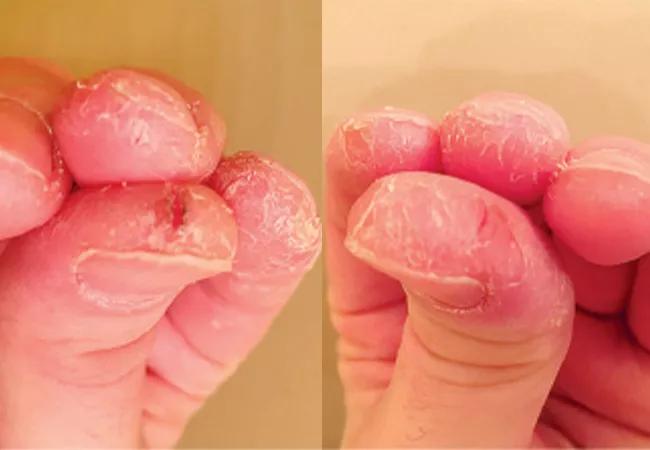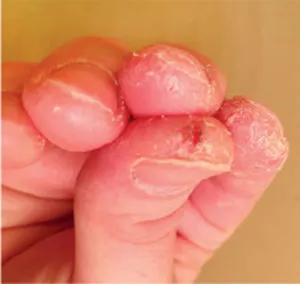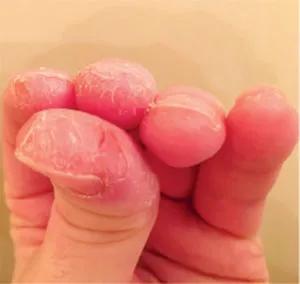Look beyond skin changes

By Soumya Chatterjee, MD, MS, FRCP
Advertisement
Cleveland Clinic is a non-profit academic medical center. Advertising on our site helps support our mission. We do not endorse non-Cleveland Clinic products or services. Policy
A 37-year-old male patient presented to our rheumatology clinic with a history of over a year of painful, cracked and thickened skin on his fingertips. In addition, he experienced difficulty raising his arms above his head and rising from a chair as well as intermittent low-grade fevers.
Examination revealed weak proximal hip and shoulder muscles as well as hyperkeratotic, thick, fissured and scaly skin on the fingertips of both hands.


Laboratory testing revealed a creatine kinase level above 20,000 U/L, negative antinuclear antibody and rheumatoid factor tests and positive tests for anti-Jo-1 (anti-histidyl-transfer RNA synthetase) and anti-SSA (Ro-52) antibodies. In addition, computed tomography (CT) of his lungs showed lower-lobe predominant peripheral ground-glass opacities, traction bronchiectasis and subpleural reticulation, all suggestive of interstitial lung disease (ILD). These findings taken together confirmed a diagnosis of antisynthetase syndrome (ARS).
ARS is a relatively rare autoimmune disease characterized by interstitial lung disease, myositis, inflammatory arthritis, Raynaud phenomenon and “mechanic’s hands,” the hyperkeratotic, scaly skin seen on this patient’s hands. Eight autoantibodies to aminoacyl-transfer RNA synthetases have been described so far: Jo-1, PL-7, PL-12, EJ, OJ, YRS, KS and Zo. Morbidity and mortality in this idiopathic inflammatory myopathy is mainly related to pulmonary complications.
Diagnosis of ARS requires a positive test for an antisynthetase antibody and both ILD and inflammatory myopathy, or one of those major criteria plus two minor criteria: polyarthritis, mechanic’s hands and Raynaud’s phenomenon.
Advertisement
Almost all patients presenting with mechanic’s hands have an inflammatory myopathy; it tends to be more common in ARS patients. Topical steroids can address the skin changes. Still, systemic treatment is often warranted as mechanic’s hands may be the most visible but not the only manifestation of AS.
For this patient, a month of daily oral prednisone 60 mg and azathioprine 150 mg resolved the mechanic’s hands as well as the myositis and ILD. We were able to taper him off the glucocorticoid and begin an ongoing treatment regimen of intravenous rituximab once every six months. The patient remains symptom free.
We often utilize our joint rheumatology-pulmonology clinic to manage patients with ARS, as ILD can be one of the most debilitating symptoms. In this clinic, decisions about the investigation and management of complicated cases like this are made in conjunction by two different subspecialists who can combine their respective perspectives. Patients appreciate getting collaborative opinions about their care from specialists with distinct areas of expertise who are experienced in managing different aspects of their disease.
Moreover, rheumatology trainees benefit from the unique opportunities to learn about the methods involved in such complex decision-making and the abundant opportunities for fellowship research projects.
This case was originally published in the New England Journal of Medicine (384;6), and figures are reprinted with permission from Massachusetts Medical Society.
Advertisement
Dr. Chatterjee directs the Scleroderma Program in the Department of Rheumatic and Immunologic Diseases.
Advertisement
Advertisement

Summit broadens understanding of new therapies and disease management

Program empowers users with PsA to take charge of their mental well being

Nitric oxide plays a key role in vascular physiology

CAR T-cell therapy may offer reason for optimism that those with SLE can experience improvement in quality of life.

Unraveling the TNFA receptor 2/dendritic cell axis

Nasal bridge inflammation, ear swelling and neck stiffness narrow the differential diagnosis

Genetic testing at Cleveland Clinic provided patient with an updated diagnosis

Proactive bone-health management may reduce morbidity and mortality